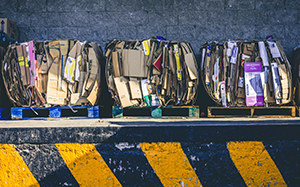
Can you Recycle Billboards?
Not only can billboards be recycled, but they can also contribute to the health of the environment!
With the mass amount of billboards located across North America, it’s fortunate that they’re capable of being an eco-friendly way of advertising. Traditional billboards can be recycled into moving palettes, backpacks, tote bags, and even surfboard bags. In 2019, Lamar Advertising Company announced that it would be repurposing 2 million pounds of PVC (polyvinyl chloride) and 3 million pounds of PE (polyethylene) materials that billboards are made of.
Additionally, there’s been a rise in unique OOH (out-of-home) advertising opportunities that are eco-friendly from the get-go. Let’s explore the fascinating ways that billboards deliver messages while also being eco-friendly.
Examples of Sustainable and Eco-Friendly Billboards
In 2017, Toyota made headlines when the company launched 37 billboards in Los Angeles and San Francisco that turned nitrogen dioxide emissions into nitrate, which is a gaseous compound that helps improve air quality. This OOH advertising campaign was brought together by Clear Channel Outdoor Americas. This method of sustainable advertising coincided with the product being pushed, a Toyota Mirai that uses hydrogen as fuel and produces water vapor emissions.
Arguably one of the coolest forms of OOH advertising is urban garden billboards. This type of board delivers an advertiser’s message while also acting as a beautiful addition to civic infrastructure. In the London neighborhood of Lambeth, an ad agency called Wildstone teamed up with Clear Channel Outdoor to bring the billboard to life. The frame of the board is made of wood and a vegetable garden surrounds the base of it. This occurred back in 2016, and unfortunately, there hasn’t been anything quite like it ever since. It was more of a unique situation rather than a revolutionary practice that altered the entire industry.
Another eco-friendly example is solar-powered digital billboards. The generation of electricity for the ever-increasing amount of human technology can have a negative impact on the environment. Power plants burn fossil fuels to create heated steam that pushes turbines to create electricity. These power plants give off high emissions of carbon dioxide and other gaseous compounds that are bad for air quality. The alternative to this is solar-powered digital billboards. Solar power is considered one of the cheapest sources of electricity, which makes it very attractive to advertisers who want to save money.
E-paper displays use reflected lights to show messages regardless of lighting circumstances. This leads to lower power requirements, but the display visuals have very low contrast. A good example of what this display looks like is the original Kindle E-reader. It’s as if you’re looking at a piece of paper rather than a display with RGB coloring.

